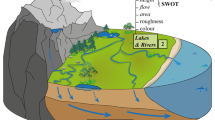Abstract
Floods and associated landslides account for the largest number of natural disasters and affect more people than any other type of natural disaster. With the availability of satellite rainfall analyses at fine time and space resolution, it has also become possible to mitigate such hazards on a near-global basis. In this article, a framework to detect floods and landslides related to heavy rain events in near-real-time is proposed. Key components of the framework are: a fine resolution precipitation acquisition system; a comprehensive land surface database; a hydrological modeling component; and landslide and debris flow model components. A key precipitation input dataset for the integrated applications is the NASA TRMM-based multi-satellite precipitation estimates. This dataset provides near real-time precipitation at a spatial-temporal resolution of 3 h and 0.25° × 0.25°. In combination with global land surface datasets it is now possible to expand regional hazard modeling components into a global identification/monitoring system for flood/landslide disaster preparedness and mitigation.






Similar content being viewed by others
References
Adler RF, Huffman GJ, Chang A, Ferraro R, Xie P, Janowiak J, Rudolf B, Schneider U, Curtis S, Bolvin D, Gruber A, Susskind J, Arkin P, Nelkin E (2003) The version-2 Global Precipitation Climatology Project (GPCP) monthly precipitation analysis (1979-Present). J Hydrometeor 4:1147–1167
Artan G, Verdin J, Asante K (2001) A wide-area flood risk monitoring model. Fifth International workshop on application of remote sensing in hydrology, Montpellier, France, October 2–5
Asante KO, Dezanove RM, Artan G, Verdin J (2005) Developing a flood forecasting system from remotely sensed data for the Limpopo Basin. J Spatial Hydrol, in review
Caine N (1980) The rainfall intensity-duration control of shallow landslides and debris flows, Geografiska Annaler 62A:23–27
Cannon SH, (1988) Regional rainfall-threshold conditions for abundant debris-flow activity. In: Ellen SD, Wieczorek GF (eds) Landslides, Floods, and Marine Effects of the Storm of January 3–5, 1982, in the San Francisco Bay Region, California: U.S. Geological Survey Professional Paper 1434, p 35–42
Dai EC, Lee CF, Nagi YY (2002): Landslide risk assessment and management: an overview, Eng Geol 64:65–87
Finlay PJ, Fell R, Maguire PK (1997) The relationship between the probability of landslide occurrence and rainfall. Can Geotech J 34:811–824
Gesch DB, Verdin KL, Greenlee SK (1999) New land surface digital elevation model covers the Earth. EOS, T Am Geophys Union, 80(6):69–70
Hong Y, Hsu KL, Gao X, Sorooshian S (2004) Precipitation estimation from remotely sensed imagery using artificial neural network–Cloud Classification system, J Appl Meteorol 43(12):1834–1853
Hong Y, Adler R, Huffman G (2006a) Evaluation of the NASA multi-satellite precipitation analysis potential in global landslide hazard assessment, Geophysical Research Letter (in press)
Hong Y, Adler R, Huffman G, Negri A (2006b) A conceptual framework for space-borne flood detection/monitoring system, EOS Transaction, AGU, May 23–27, Baltimore, Maryland
Hong Y, Adler R, Huffman G (2006c) An experimental global monitoring system for rainfall-triggered landslides using satellite remote sensing information, IEEE trans. on geosciences and remote sensing (in press)
Hong Y, Adler R, Huffman G, Negri A (2006d) Use of satellite remote sensing data in mapping of global shallow landslides susceptibility, Nat Hazards. DOI 10.1007/s11069-006-9104-z
Huffman GJ, Adler RF, Bolvin DT, Gu G, Nelkin EJ, Bowman KP, Hong Y, Stocker EF, Wolff DB (2006) The TRMM multi-satellite precipitation analysis: quasi-global, multi-year, combined-sensor precipitation estimates at fine scale. J Hydrometeor (in press)
Iverson RM (2000) Landslide triggering by rain infiltration, Water Resour Res 36:1897–1910
Janowiak J, Joyce RJ, Yarosh Y (2001) A real-time global half-hourly pixel-resolution infrared dataset and its applications. Bull Amer Meteor Soc 82:205–217
Katiyar, Nitin Faisal Hossain (2006) An open-book modular watershed modeling framework for rapid prototyping of gpm-based flood forecasting in international river basins, EOS Transaction, AGU, May 23–27, Baltimore, Maryland
Larsen MC, Simon A (1993) A rainfall intensity-duration threshold for landslides in a humid-tropical environment, Puerto Rico: Geografiska Annaler, 75A, p 13–23
Mahdi T (2007) Pairing geotechnics and fluvial hydraulics for the prediction of the hazard zones of an exceptional flooding. Nat Hazards. DOI 10.1007/s11069-006-9096-8
Negri A, Burkardt N, Golden JH, Halverson JB, Huffman GJ, Larsen MC, Mcginley JA, Updike RG, Verdin JP, Wieczorek GF (2004a) The Hurricane-Flood-Landslide Continuum, BAMS, DOI:10.1175/BAMS-86-9-1241
Negri AJ, Golden JH, Updike RG (2004) The hurricane-flood-landslide continuum -forecasting hurricane effects at landfall, american meteorology society annual conference, Miami, Florida, Jan, 2004b
Verdin K, Verdin J (1999) A topological system for delineation and codification of the Earth’s river basins. J Hydrol 218:1–12
World Disasters Report (2003) International Federation of Red Cross and Red Crescent Societies (IFRCRCS). Preparedness for climate change, a study to assess the future impact of climatic changes upon the frequency and severity of disasters and the implications for humanitarian response and preparedness. Geneva:IFRCRCS.P239
Acknowledgment
This research is carried out with support from NASA’s Applied Sciences program under Steven Ambrose of NASA Headquarters.
Author information
Authors and Affiliations
Corresponding author
Rights and permissions
About this article
Cite this article
Hong, Y., Adler, R.F., Negri, A. et al. Flood and landslide applications of near real-time satellite rainfall products. Nat Hazards 43, 285–294 (2007). https://doi.org/10.1007/s11069-006-9106-x
Received:
Accepted:
Published:
Issue Date:
DOI: https://doi.org/10.1007/s11069-006-9106-x




